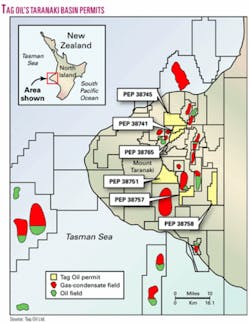New Zealand is an underexplored place where a small company can make a large discovery, opines Drew Cadenhead, president of Tag Oil Ltd.
Tag Oil has been in existence 10 years and focused on New Zealand for the last three years.
Speaking from his office in New Plymouth, NZ, Cadenhead said Tag Oil has a headquarters in Calgary and raises capital in North America.
New Zealand, he said, represents a “unique combination of fiscal, economic, and technical opportunity.” Only 10 fields are producing, but opportunities are everywhere.
A geologist for 25 years in Calgary, Cadenhead took a 3-year contract to explore New Zealand with the former Fletcher Challenge Oil & Gas Ltd. and realized that some companies in the Southwest Pacific country were “bypassing opportunities that would have been prized in Calgary.”
So, Tag Oil has spent $5-6 million picking up land, acquiring seismic data, and placing itself in position to explore. Now it has begun a 2 to 3-year drilling program that is expected to involve 16 wells from shallow to as deep as 4,000 m.
Learning curve
Tag Oil had a ready-made learning curve in his experience in the country, Cadenhead said.
Employing that knowledge, Tag Oil has become one of New Zealand’s largest acreage holders with 1.5 million net acres among more than 4 million gross acres on the North and South Islands. The present portfolio is in the staple Taranaki basin and the frontier, nonproducing Canterbury basin.
“A number of other basins interest me,” Cadenhead said.
One of New Zealand’s attractions is its lightly explored status. It has only about 350 exploration wells and is similar in size to Alberta, which has 500,000 wells, Cadenhead said.
Government agency Crown Minerals, Wellington, points out that the country has 250,000 sq km of land area plus the world’s fourth largest Exclusive Economic Zone at 4 million sq km. And it says the ocean area likely to come under future jurisdiction as a result of the UN Convention on the Law of the Sea may amount to 6 million sq km.
The government is scrambling to attract operators and stimulate more exploration. One new player, Pogo Producing Co., Houston, has proposed a 428,000-acre marine 3D seismic survey on exploration areas that cover 1,043,000 acres of the Taranaki shelf off New Plymouth and between shore and Maui field (OGJ Online, Feb. 6, 2004).
The government has sharply reduced royalty rates on oil and gas and has made a large amount of data available to operators at low cost, Cadenhead noted.
Crisis situation
New Zealand is in a gas demand crisis that stems mainly from the decline of Maui offshore gas, oil, and condensate field. More than 80% of New Zealand’s production has come from Maui and Kapuni fields.
Maui is in advanced decline. Discovered in 1969, it has produced for 25 years and is nearing depletion. It sustained the country so long that it may even have discouraged explorers from coming in for a time, Cadenhead said.
Auckland has experienced brownouts the last two winters, and hydrocarbon consumers have become willing to expend funds for a call on gas discovered. For instance, Swift Energy Co., Houston, last month completed New Zealand’s deepest penetration as part of a joint venture financed by an Auckland power company. The Tawa B-1 exploration well in the Rimu-Kauri area was dry at TD 18,688 ft.
Large gas users have approached Tag Oil about its program in the Canterbury basin, Cadenhead said.
Of Taranaki basin discovered recoverable volumes of 438 million bbl of oil and condensate and 6.5 tcf of gas, 11.7 million bbl and 234 bcf were produced through June 2002.
Tag Oil’s program
Taking its turn with availability of New Zealand’s 4-5 drilling rigs, Tag Oil has participated in three wells so far in 2005 and has several spud dates committed in 2006, Cadenhead said.
The company holds six permits in the Taranaki basin producing fairway.
Tag Oil was spudding its first 100% interest well, the directional SuppleJack South-1, in early December for a planned TVD of 2,000 m.
The surface location is on PEP 38741, near the SuppleJack-1 dual zone gas-condensate discovery made in September 2005, but the bottomhole spot is in PEP 38765 at a seismically identified sweet spot about 700 m from SuppleJack-1.
Richmond-1 went to TD 2,140 m on PEP 38745 on a stratigraphic prospect in the northern Taranaki basin. It found the objective Miocene Moki sandstones but was not commercial, Cadenhead said.
Konini-1 went to TD 2,096 m in PEP 38751 near the Kapuni, Surrey, and Cheal discoveries and was plugged after reaching the main objective sandstones. It targeted the Miocene Mount Messenger formation, the producing formation in the nearby Cheal oil pool.
Next up is the Arakamu-1 exploration well 4 km south of Cheal in PEP 38757. A Tag Oil 100% well, it will test multiple Miocene-aged targets including the proven oil and gas horizons at Cheal. It is projected to 2,250 m.
Tag Oil has a July 2006 spud date for a well to 1,400 m on Taranaki PEP 38758 at a site less than 4 km from the Waihapa/Ngaere permits. Tag Oil plans to acquire 2D seismic data in the first quarter of 2006 to confirm encouraging results of a soil sniffer survey that involved taking 3-m deep core plugs at 2,000 points on the permit.
South Island
Whoever is first to produce oil on the South Island would likely export to China as happens with the rest of New Zealand’s produced oil, Cadenhead said.
If commercial gas is found, a power company likely would build a generating station near Christchurch, population 500,000.
Tag Oil has an October 2006 spud date for the first well on its coastal Kate prospect in the Canterbury basin, South Island. This will be drilled to 1,500 m with a rig moved from the North Island.
Tag Oil acquired 2D seismic data over this large surface anticline in June 2005 and was encouraged enough to commit to a more extensive 2D program set for the first quarter of 2006. The prospect covers more than 15 sq km and has numerous high-quality oil seeps on its perimeter. ✦
Career highlights
Drew Cadenhead is president, chief executive officer, and a director of Tag Oil Ltd., Calgary.
Employment Cadenhead is a former exploration vice-president for BTU Resources and former senior geologist with Ulster Petroleums. Besides the consulting stint with Fletcher Challenge, he worked three years with PetroCorp, the former New Zealand government oil and gas exploration company.
Education Cadenhead holds a bachelor’s degree in geology from the University of Calgary.


